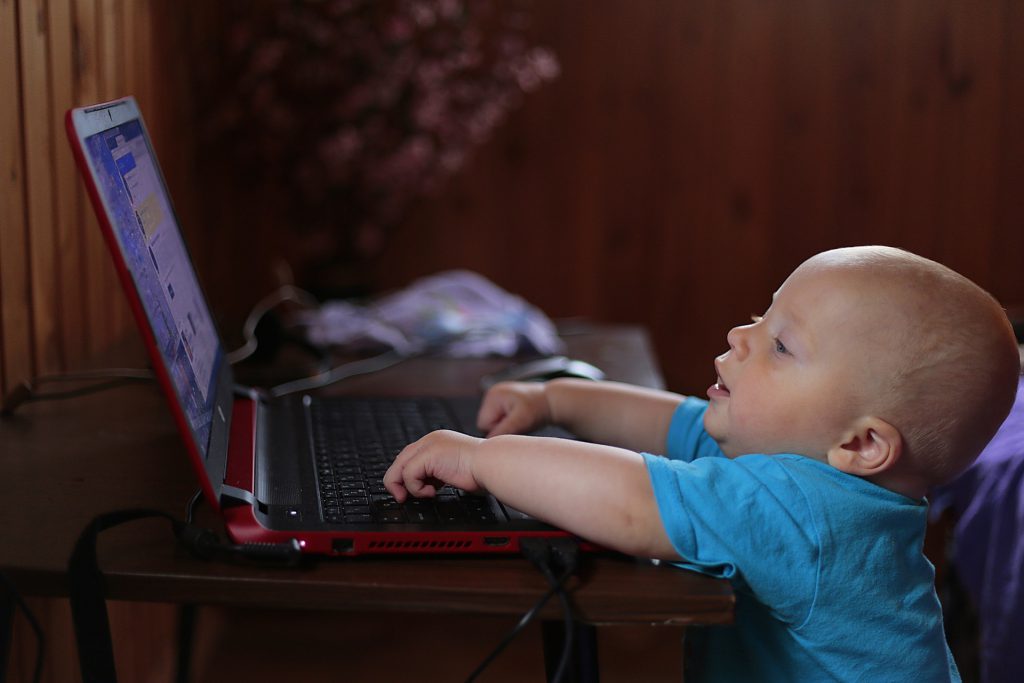Two Approaches To Parental Internet control: is Zero Tolerance the Only Way?

What’s the best approach for parents who want to protect their children from the more dangerous side of the internet? There are a number of different ideas out there, but broadly speaking they can be put into two main categories: zero tolerance and taught responsibility. Kidslox can be a helpful tool for turning either of these strategies into a household reality, whichever route you choose. Let’s review what that might look like in practice.
1. Never use the internet
In her recent BBC interview, cyber psychologist, Professor Mary Aiken advised listeners that children shouldn’t use the internet. Ever. Her concerns revolved around the availability of “extreme content” and what she perceived as the ineffectiveness of parental control software, with our tech-savvy kids finding ways to get round restrictions.
What was refreshing was she didn’t feel the urge to berate parents for our technical inadequacy.
On the contrary she expressed her concern and frustration that parents are expected to bear the full weight of responsibility for their children’s online safety. As she points out “we don’t expect parents to man the doors to bars … or man the cigarette counters in newsagents”. So why task parents with almost “exclusive responsibility for children in a cyber context”?
Hear hear.
Sure Professor Aiken’s view is coloured by her time working with those worst affected by the internet’s less savoury end. But she’s got a point.
The burden of responsibility Aiken mentions is something so many of us feel. That burden combined with our own personal battles with ineffective parental control solutions are a large part of the inspiration that led us to develop Kidslox.
Kidslox as an internet restriction tool
For those willing to take her advice, Kidslox is a good option for allowing children to use a device while keeping internet browsers completely disabled. Kidslox is not easily overridden: the restrictions it sets can’t be circumvented by changing a few preference settings. Only the controlling device (the parent’s device or web account) is able to decide which apps and device functions are available to use.
2. Use the internet safely
For many of us though, Aiken’s blanket ban is too extreme (not to mention too late). Our children are growing up with the internet, and our ability to enforce zero tolerance would be unrealistic and understandably intolerable to our kids. Rather as the interviewer in the clip suggested, there’s much to be said for a healthy use of the internet eg. for researching a school project.
Kidslox and other parental control software offer parents a degree of control over their children’s screen time, apps and internet access. When children are using their own or other household devices, this can be an effective way to keep them safe from extreme content and from the dangers inherent in excessive screen time. Kidslox also works on 3G or 4G, so while there’s still the danger of what they can see on their friends’ phones or at their houses (as Aiken remarks) it extends parental boundaries as far as humanly – and technically – possible.
We don’t like to believe in this sci-fi, nightmarish Brave New World Aiken paints. Where the only way out is to raise technologically illiterate children. Or live with the parental shame of a corrupted child, traumatised by all the evil things they’ve been subjected to online.
It’s all a bit melodramatic.
Yes it’s an ongoing challenge to get the balance exactly right, but a healthy approach to internet usage is achievable.
Kidslox and a healthy relationship with technology
How is this achieved? Well it takes a bit of good, old-fashioned offline groundwork. Otherwise known as a chat. Talk to your kids about the risks and dangers of the internet. Tell them about Aiken’s patients if you like, unable to ‘unsee’ the content they’ve exposed themselves to. Point them towards good search habits. Teach them how to recognise trustworthy sites. And if you’re not sure about those things, teach yourself first.
Parental controls can be a great support here: Kidslox can be used to keep browsers locked at times when you’re not around to supervise or to restrict access to inappropriate apps. So you can stop your children’s curiosity (or disobedience) from taking them to sources of inappropriate content, until you feel they are mature enough to take on some of that responsibility themselves.
Parental controls on technology aren’t like waving a magic wand. But when used as part of a deliberate, holistic strategy, with an emphasis on teaching positive, responsible technology use, we at Kidslox would like to think they offer real hope and help.
After all that was our goal when we developed Kidslox. And it still is.
From Spying To Total Trust: 5 Different Approaches To Parental Controls

There are a lot of very varied views out there about how best to handle the way children and teenagers use mobile devices, the internet and screens in general. Every family and every child is different and needs to have a personal approach tailored by the parents involved. Despite these varying needs though, some solutions seem to have a much wider application than others.
We’re going to take a look at five different approaches to parenting strategies for mobile devices. Each approach falls onto the trust/control scale (shown below) at a different point, as the essential difference between them is the balance that they find between trusting your children to do the right thing and keeping control over everything they access and do with their devices. Obviously we feel that Kidslox is the approach with the widest application and the most appropriate balance of trust and control, but as I wrote above, every family is different and needs to evaluate their needs individually.
Stealth Control and Monitoring
This approach to parenting children’s devices essentially amounts to spying on them. You watch everything they do, post, write to friends etc. and remotely control their devices for them without their knowledge. To us, this seems an obvious parental over reach and we wouldn’t advocate it as an option for any family. We’ve had a number of parents request similar functions for Kidslox though and the fact that there are ‘stealth’ products like XNSPY, MobiStealth and PhoneSheriff out on the market shows us that it’s an option some parents are willing to pay for.
Secretly spying on your children is problematic for a number of reasons, 3 of which I’ve set out below:
- You demonstrate your lack of trust in your children
- It doesn’t set any standards for the children to live up to, only enables arbitrary seeming punishment after they go too far
- It teaches kids to be paranoid and hide their activity even better
Total Trust
It would be great to think that we could trust our kids to do the right thing in every situation and that they’re responsible enough to limit their own screen time, use only appropriate games and sites and tell you if they encounter anything or anyone that makes them uncomfortable.
That might sound especially naive, but fans of this approach would place extra emphasis on talking to their children about the dangers inherent in technology and asking them regularly about the apps they use and the sites they go on. Creating a wider atmosphere of openness and trust to encourage children to take responsibility for their own behaviour.
As children grow into teens and teens into young adults obviously we’d hope that whatever approach is used it gradually turns into this, but I think it’s fair to say that most parents experience would lead them to call this an unrealistic option at first and largely advocated by yet-to-be parents.
Open Control and Monitoring
This approach to the problem is much closer to the way Kidslox operates than the previous two. It also combines elements of both; when you install parental control software openly on your child’s device, you also need to talk with your child about the reasons why you’re doing it and what boundaries you’ll be setting.
One of the reasons we created Kidslox though, is because many parental control products which take this approach are still very invasive. With apps like Pumpic encouraging parents to read texts and emails and constantly track their teenagers whereabouts, essentially controlling behaviour through the fear of being watched or caught.
Pros
- Initiates conversation about the dangers of technology
- Provides a framework for sensible boundaries
Cons
- Children get used to it and it becomes essentially the same as the spyware
- Invasive over-monitoring builds paranoia in parents and secrecy in kids
Low-tech monitoring
I’ve read a number of articles suggesting the implementation of an ‘open phone policy’ or something similar. Essentially a verbal agreement between teens and parents that the parents are allowed to look through their child’s phone and social accounts at any time. It’s actually quite a tricky approach to place on the scale above, because whilst it does demonstrate a high level of trust in the kids ability to manage their own activity, it also
Whilst I quite like this system as a conversation generator and as a demonstration of trust in the kids while not letting the issue go unaddressed, the risks inherent in having too much screen time are not part of the equation and where parents and kids fundamentally disagree over the appropriateness of an app the parent can only rely on the strength of their own authority. For some families it will be the right choice, but for most I suspect more direct control over screen time is required.

The Kidslox Approach
Of course we’re always working to make Kidslox better, but we feel that we’ve got the balance of trust and control just about right. Kidslox lets parents set limits on disruptive and potentially dangerous screen time and allows the blocking of apps they deem inappropriate without taking invasive measures against the child’s privacy. There’s room for varying levels of strictness within Kidslox, but no temptation to start all out spying on your kids.
As with the open control apps, Kidslox is best used as part of a parenting strategy that includes plenty of talking with the children about the dangers of technology. Explanation of the limits you’re setting, the reasons for them and the times they’ll be applied helps children to both accept them and hopefully also begins the process of leading them towards even more trust based approaches.
Don’t let the issue pass you by
In today’s screen filled world it’s not an issue to let slide. Whatever solution you decide is best for your family, it’s important to make sure you’ve at the very least talked about the problem of screen time and about the risks inherent in internet use, social media and many other mobile apps.
Whether implemented for disciplinary reasons, to stave off tech dependence and addiction or simply to protect kids from the inappropriate, Kidslox is a solution that we’re proud to be associated with, use in our own homes and think provides exactly the sort of balance that many families are looking for. Perhaps it’s what you’re looking for too?
9 Reasons To Consider Parental Control software For Your Kids

Sometimes post-millennials get called the “iGeneration”. It feels like an accurate term given the way so many kids spend much of their leisure time not outdoors playing with friends but instead glued to tablets and smartphones. They play video games, watch YouTube videos, keep up to date on different social media platforms and chat in a variety of messenger programs. This is exactly why parental control software came into existence.
Parental control software
Parental controls are special tools that help parents to take control of the way their children use devices. There are various different types of parental control apps on the market which come with different sets of functions, prices, and platform compatibility. You might consider such tools to be your extra pair of eyes, to help you keep tabs on your child’s online activity and keep your kid safe. While most mobile devices have built-in parental controls, they’re often very limited in scope. That’s why purchasing a more comprehensive piece of parental control software can be a great investment. Let’s look at the reasons you might find such apps helpful:
Top 9 reasons to use parental controls
1. Internet addiction. This can be a real problem for your child unless you help them to cope with it. Kids can spend hours surfing the web without considering the amount of time going by at all. They could spend this time more effectively doing their homework, playing sports or just socializing with friends. Parental controls can help resolve this issue. They enable you to apply a time limit for device usage or schedule exactly when your child can use their screens.
2. You can’t always be there. You can’t always be there to look over your kid’s shoulder to keep track of what they’re engaging with. What you can do is remotely enable or disable apps as you choose appropriate and set content filters on the sites they’re able to access.
3. Multiple device challenge. Modern families often have a messy collection of cell phones, iPads and laptops. That can make it hard to keep track of what’s happening on all the gadgets at the same time. Parental control programs can provide you with cross-platform control of large numbers of devices, allowing you to adjust the restrictions for each one to precisely fit your family’s needs.
4. To provide a safe internet experience. Conversations about safe browsing are important, but are they enough? Probably not. 70% of children aged 7-18 have accidentally run into online pornography, often just googling their homework. Make sure your child won’t bump into any sexual or violent content by applying a web filter. It gives the ability to block bad websites from appearing either by mistake or intentionally, so that you don’t need to worry about inappropriate content.
5. Cyber-bullying and online grooming. One downside to the fact that mobile devices are such powerful communication tools, is that they enable those who aim to misuse that ability to communicate. Cyber-bullying and online grooming are both serious threats to our children’s mental and physical wellbeing. Parental tools can be used to block chat sites or social media where bully’s or other predators might try to get in contact with our children.
6. Unhealthy gaming. Games are addictive. They’re intentionally designed this way and the resulting obsession can have serious implications. If engagement with the virtual world is getting in the way of other parts of your teens life, it’s probably time to step in with the parental controls. If you can see that your kids are that way inclined, you might want to use game time limits or scheduled play sessions much earlier.
7. Depressing content. Depression is the scourge of our times, affecting not only adults but young people as well. In recent years the number of teens who had at least one episode of major depression increased by 60%. And between selfie culture’s focus on image and social media’s carefully curated echo chamber, the Internet only turns up the heat. Teens are especially susceptible to this effect as their brains are still developing.
8. Help your kids to manage their time. How many times have you had quarrels with your child about screen time ending with tablet confiscation? With parental control software just set the screen time you want to allow and the app will shut down the device when the time is over. Or if you need a device to be turned off now, you can do it instantly from your own phone. Teaching kids to manage their time effectively is a valuable life skill.
9. Create time for getting the family together. Don’t let those precious moments of family time to be spoiled with cell phone interruptions. Either you want to discuss family matters at dinner or enjoy the weekend trip with your children, consider parental controls to limit their time spent in games and social media.
Managing, not spying
Remember that trusting relations between you and your child are well worth building and treasuring. Parental control software is not a tool for spying on your child but rather a management tool to set sensible boundaries that help them to navigate and use the digital world effectively and safely. This should be accompanied by conversations about screen time and online safety. Kids should be aware of the potential dangers and the reasons why parental controls are being installed on their device.
Parental Controls And Their Role In Creating better Quality Family Time
If you use parental controls to manage your children’s screen time, you don’t want it to become a big deal. It’s there to keep them safe, to handle or avoid a problem with excessive screen use or possibly as a way of teaching a responsible approach to the internet and digital media. Maybe even all three. It’s not there to cause conflicts. If anything you’d hope they’ll reduce potential conflict situations. So how can we make sure that our use of parental controls is appropriate, effective and steers clear of tears?
Different types of parental controls
 Parental controls let you monitor or manage different device typesFirst of all, we should understand that not all parental control solutions are alike. Android parental controls are able to achieve very comprehensive coverage of a wide range of features while developers of iPad and iPhone parental controls are much more limited in what they’re able to offer. Whatever operating system you’re on, the 3rd party systems available to you use a number of different approaches to achieving the goals of parental controls. These approaches are essentially formed by a mix of device monitoring features and device management features.
Parental controls let you monitor or manage different device typesFirst of all, we should understand that not all parental control solutions are alike. Android parental controls are able to achieve very comprehensive coverage of a wide range of features while developers of iPad and iPhone parental controls are much more limited in what they’re able to offer. Whatever operating system you’re on, the 3rd party systems available to you use a number of different approaches to achieving the goals of parental controls. These approaches are essentially formed by a mix of device monitoring features and device management features.
Device Monitoring
Device monitoring features might include geofencing, the ability to view browsing history, call and sms history, total screen time and a breakdown of it’s usage. Essentially any feature that allows you to better understand the way that your child is using their device, without changing what they’re able to do on a technological level.

These sorts of features come with a debate of their own: whether or not it’s good practice for parents to spy on their children’s device and internet use. Both sides have their advocates. Some argue that children do not have privacy rights where parents are concerned, they earn privacy as a privilege by demonstrating responsibility. Others would argue that you foster responsibility in your children by trusting them to behave well within the boundaries you set. Where you fall on that spectrum might determine which device monitoring features you look for in a parental control solution.
On the other hand, your decision might be less philosophical and more practical. If your main concern is keeping track of your kids’ whereabouts, you just need a good family locator app.
Device Management
Device management features are those features which let you directly affect the way your child uses their device. This includes app blocking, internet blocking, screen time schedules and limits, internet content filtering, camera blocking, in-app purchase restrictions and much more.
Parental controls iPad, iPhone and AndroidWhere monitoring features just observe, managing features play an active role in establishing the boundaries you want your kids to follow. Turning the phone off at bedtime. Disabling access altogether to content too mature for them. You get the idea. Many would suggest that device management is more appropriate for younger children. It can help them to form good habits. Monitoring services on the other hand are seen as fitting the bill better with teenagers, to check that they’re behaving as they should. In real life though the situation is usually much more complicated than that.
For a start, in most cases parents realise they need parental controls only in response to a problem that’s already developed, not as a preventative, habit forming method. As a result, this means that older children and teens often need to have devices managed too.
Using a pact app
The large majority of parental control apps available today can be described as “pact apps”. Essentially this just means that the child knows the app is installed on their device (you’re not all out spying on them). When you install software on your child’s device, explain to them what it’s for and why you’re putting it there. If possible, you want to explain the boundaries you’re setting such that your child agrees with them. In this way, a pact is entered into, which the software simply enforces.
It might be tempting to just install some software and let them deal with it. But talking like this is essential to encouraging ongoing good habits. Parental control software is a tool to help you raise tech smart, socially responsible children. A computer program can’t do that on it’s own though. You need to be discussing and modelling what appropriate and safe online behaviour is with your children. A pact app offers a great way to begin that conversation.
What’s right for my family?
 Which parental controls are right for my family?Ultimately, you’ll need to decide what approach you want to take on the basis of your family’s needs. You might not want to restrict any content, but block device use at certain times of day. Perhaps you need a way to give screen time as a reward for good behaviour or an app lock to block access to inappropriate games. Whatever the need, decide on an appropriate response and search for parental controls tailored to meet that need.
Which parental controls are right for my family?Ultimately, you’ll need to decide what approach you want to take on the basis of your family’s needs. You might not want to restrict any content, but block device use at certain times of day. Perhaps you need a way to give screen time as a reward for good behaviour or an app lock to block access to inappropriate games. Whatever the need, decide on an appropriate response and search for parental controls tailored to meet that need.
Creating high quality family time, both with screens and without them, is always a worthy goal. Parental controls are one particularly versatile tool that we have to help achieve that.
Best parental control app
Here at Kidslox we obviously like to think that we offer the best parental controls on the market. It’s not just talk though, we’ve got a lot of reasons for our confidence. One of them is that our system is very easy to use and understand. Yet it still manages to be relevant to a large number of different family situations. All of the different scenarios I described in the last paragraph can be resolved using Kidslox parental controls! It doesn’t end there though.
In a few days time we’ll be releasing our long awaited ‘Daily Limits’ function. It lets you set a fixed amount of screen time which your child is able to use in the course of the day. This makes it much easier to control screen time use in line with official recommendations. This will be joining our extensive existing feature list. So whether you need to filter web content, block apps, block internet or set usage schedules on iOS or Android, Kidslox is the right choice for you.
Parental Controls Are Worth It, Even If Your Kids Are Super Tech Savvy

Working for a parental controls app, the topic of parental controls comes up in my conversations at what is probably an above average rate. When it does, one of the go to opinions I hear from people time and again is that there’s no point trying to restrict device use as today’s kids understand tech better than we do and will quickly work out a way around it.
There’s an extent to which they’re right, I’ve tried out not only Kidslox but a lot of our competitor products too and ultimately an inquisitive, keen young mind, set on finding a way round these systems can probably do so. Even as we find ways to close the known loopholes, (keep you eyes open for our upcoming Android updates), children can still potentially use a friend’s iPhone or an older sibling’s tablet to try and bypass the system altogether. Attempts to filter content or block functionality are seen by some as a cat and mouse game destined for failure. The only effective solution is to talk often and openly about what is and isn’t appropriate use of technology and model the same.
Despite the seeming validity of this objection, I still firmly believe in parental controls as a concept and Kidslox in particular as a solid solution with an approach that balances parental control and child privacy. Why is that?
Parental controls have a clear role
First of all, I agree with those who say that talking about and modelling responsible technology use are essential to developing it in our children. Having laid out some ground rules in conversation though, I think it’s appropriate (especially with younger kids) to back up these rules with parental controls.
Parental controls make it easier for kids to keep to the rules or guidelines. If you have a rule that says ‘no games for an hour before bedtime’, but the device is in their room with no limitations on it and they know you’re unlikely to check in on them, the temptation can be overwhelming. If there’s a technical limitation, it makes the rule more understandable and real in the child’s life and therefore easier to follow.
Many children (again, especially younger kids) accept their device at face value and don’t find ways to circumvent limitations. To some this might seem naive, but it’s true that whilst some kids today are extremely tech savvy and can easily find the weak points in a system, many just haven’t had that same exposure to technology or don’t have that same sort of interest in exploring device settings and so on. You know your own children best, will they accept a limited device at face value or will they look for ways around it?
Mine will definitely try to get round it
Where children are inclined to push against the rules, the importance of making sure that parental controls are used as part of a wider conversation about appropriate tech use becomes paramount. Coming to an agreement with your kids about what is acceptable tech use is essential, but if your kids are inclined to stretch boundaries to the limit, you need more than anyone to know when they take things too far. Controls like Kidslox give you confidence that the rules are being kept to most of the time and if the app gets removed you get sent a notification. We’d always recommend talking with your child before installing parental control software, explaining what limits you’re putting on their device, why you’re putting them there and establishing a consequence for trying to disable the controls (device confiscation for example).
Parental controls give you confidence to let your child use their device. It’s easy to be scared by the different horror stories circling online, from the ready availability of extreme and explicit content to the danger of bullying, over-sharing and other social media based threats. Parental controls can give you peace of mind about your child using a given app or site without worrying that they’ll be led astray or happen across something upsetting. (Explaining this reason for using the controls to your child can help them to accept the limitations you place).
Kidslox has a clear role
A lot of parental control software puts an emphasis on “spying on your kids”. Reading their messages, checking their browsing history and so on. Whilst this approach might conceivably have a place for the parents of the most rebellious young teens, it’s not something that I’d endorse or suggest for the vast majority of parents. In using such programs a parent in one move leaves their child responsible for navigating the dangers posed by unrestricted technology use at the same time as they demonstrate their own mistrust that the child can handle that responsibility.
Kidslox approach provides clearer limits (device lockdown, inaccessible apps and other blocked features and content) whilst maintaining the child’s digital privacy. The boundaries are easy to explain to kids and therefore easy to incorporate into a wider conversation about technology use. The child is left free to use the allowed content without being spied on.
In the end, every parent needs to decide what’s best for their family based on their own needs. With the ever increasing role that screen time plays in our children’s lives, (not to mention the risks the online world poses them), Kidslox is the right choice for an ever increasing community of parents.
Digital Rehab And Parental Controls

Nomophobia
Have you encountered the word “nomophobia” getting bandied around in the media? It was coined back in 2008 (despite already existing, but that’s another story (check out the wikipedia link above for more)) and has occasionally floated back into the public conscious.
It’s the irrational fear of being unable to use your phone (no mobile phobia), perhaps because of lack of battery, minutes, or network coverage or perhaps because you accidentally left it somewhere, or dropped it somewhere unretrievable. Obviously these incidents are fairly likely, so it’s not irrational to suppose they might happen. What’s irrational is the level of fear and anxiety encountered by nomophobia sufferers when this situation arises.
Digital addiction
Perhaps what nomophobes really ought to be worrying about is exactly the opposite! There’s a growing concern about the effects that spending too much time online / in front of screens can cause. “Internet addiction” and “device addiction” are shouted down by some as not being real addictions, but there are enough people taking such ideas seriously that addiction treatment programs and digital detoxes are appearing in growing numbers.
What this shows us is that regardless of what we call it, excessive or inappropriate mobile device use causes real problems for a significant number of people. Because of the social acceptability of engaging in device use in a large majority of contexts along with children’s ready access and still-developing minds, our children are especially at risk.
Digital rehab in your pocket
For a full blown addiction, with it’s associated debilitating effects on school/work, relationships and other areas of life, professional psychiatric help is definitely recommended! If we’re just talking about a bad habit, a predilection for staying up late to watch youtube videos, an unwillingness to look away from the phone during mealtimes or similarly disruptive niggles, parental control solutions can be a pathway to developing new, healthier habits.
Whether it’s games, social media, online videos or something else that draws your kids to use their mobile devices constantly, you can design an approach that helps them to get some balance back into their lives. That might mean simply blocking device access at meal times. It might mean placing time limits on specific games or social media platforms. It might mean placing a night time curfew on device use. Whatever the mobile device based issue you’re trying to address, parental controls are a vital tool to help you achieve it.
6 Hours Of Screen Time A Day Is Ok. Are Parental Controls Still Relevant?

A recent study published in Psychiatry Quarterly suggests that up to 6 hours of screen time is perfectly reasonable for teenagers and not associated with behavioural problems.
The study was made in Florida and bases its findings on data from more than six thousand teenagers. The teens were asked questions about their screen time, sleep, school grades, family patterns and issues like depression and risky behaviour.
Screen time: is there really a problem?
Is this the good news that we parents have been waiting for? Can we now relax and forget about parental control and screen time issues? Maybe worrying about excessive screen time is just the latest fad parental panic, like rock and roll music or comic books in the 50’s. It’s time to get over it and calm down. Or is it?
It is difficult to overstate the growing role of the computer and internet over the last couple of decades. Today, these incredible inventions have penetrated almost every sphere of human activity. It’s essential for our kids to have a good understanding of how to use them effectively in order to participate in society and take advantage of the opportunities available to them.
That said, concern over how much time your child spends on their computer or smartphone is not the same as panicking. Rather, it shows that you are a responsible parent who is aware of the immediately observable effects that screen time has on your child.
The study mentioned above shows that up to 6 hours of screen time is not connected to a range of serious risky behaviours or to depression in young people. That’s great. But much smaller (probably harder to measure) problem behaviours are immediately observable when we give our kids mobile devices.
Smaller Problems
I don’t want my children to be rude, to ignore the people in the room in favour of people online, to get their sense of self worth from social media likes. I’m concerned by their lack of interest in reading and preference for cartoons. I don’t want them to develop addictions of any sort, whether it’s to video games, to pornography or to checking their Facebook stream. And of course I want to protect them from inappropriate materials and the risks connected with social media use from cyber bullying and identity theft through to oversharing, sexting and predatory behaviour.
Of course simply putting a limit on screen time doesn’t resolve these problems. They’re all variations on classic parenting problems and they need to be resolved through conversation and example as well as well defined boundaries.
Is there hope for parents?
Not only do this study’s findings give us cause to relax a little, there’s more concrete hope too.
- First of all, you’re not alone! The problems created by children’s access to smart devices are being encountered by parents everywhere at the moment. If you want to talk with someone about the issue, whether for advice or simply to share your frustration, it’s easy to find other parents who are ready to be part of that conversation.
- Second, there are a lot of resources available to help find good quality games and shows and to kick start meaningful conversations with your kids about their technology use.
- Third, setting well defined boundaries is currently easier than ever. Whether it’s based only on a spoken agreement or involves the use of technologically enforced boundaries too, there are a some well tried tools that can help you make the rules stick.
Parental control apps like Kidslox can give you the help you need to make your household rules about ipad or smartphone use into a reality. But there’s another option we’ve not discussed too.
Let’s try to provide our kids with top quality down time that doesn’t include screens at all! If it sounds both simple and difficult at the same time, then you’re hearing me right. We can encourage options that our kids choose over and above screens. But it requires creativity, preparation and active modelling of the sort of habits we want them to acquire. Do they really have nothing else they’d rather do for a quarter of their day, every day? Let’s find and nurture those impulses towards non-screen-based pastimes, to bring up a generation who are tech savvy, but able to put their devices down too.
Parent Apps For The Busy, Modern Mum share

It seems like parent apps are being flung at us from all sides these days. On Facebook, in the news and if the internet picks up on the fact that you’re in the market for a parent app, then every page you visit seems to be plastered with adverts for them. How can we tell which parental apps are going to be really useful for us?
Screens make bad babysitters
As parents, we’re busy, a lot. At the same time, our children like screens and want to spend more and more time on them. Perfect right? They can play on their iPads, enjoy the benefits of social media in their social lives, maybe engage with some educational apps for kids and you can get on with everything you need to do. Of course it’s not as simple as that though. We’re all too aware of the many risks and problems associated with both screen time in general and with specific types of screen time too.
Screen time risks
There are immediate dangers to be wary of like cyber bullying and the accessibility of porn and other inappropriate content. Then there are more long term risks like the detrimental effects of passive content consumption and the danger of allowing excessive screen time to lead to reduced time in other more active pursuits. The recent changes to the American academy of paediatrics screen time recommendations are double edged. They make allowance for more extensive screen viewing, especially by older children. At the same time they impress on us the need to regulate exactly what media our kids use and even how they use it.
Parent app challenges
The number one challenge then for any parent apps is that they have to make things easier. There are so many factors, so much to worry about, the tools we use have to make this situation simpler for us. This means that:
- Parent apps need to offer some clear benefit. This might seem obvious, but I’m amazed by the number of apps on friends devices that they’ve downloaded because it sounds cool and then never opened again.
- Parent apps should be easy to set up, without complicated configuration. Actually we’re often ready to put in some quality time to configure some more detailed settings if an app if it’s going to become a valuable, long term tool; but I don’t want to be faced with this when I first turn a parental control app on. I want to check that the app does what it says on the tin first, then sort out any setup details.
- Parent apps should be easy to operate and understand. One I’ve got it set up, I don’t want to invest a lot of time ‘mastering’ a parent app’s use. It should be intuitive and comfortable to achieve whatever I’ve downloaded it for.
- Parent apps should be reliable. If I start to use a tool and it meets all of the criteria above, I might start to rely on it on a daily basis. If it’s performance is unreliable, this then has a knock on effect on my day.
Parent apps from the child’s perspective
The parent’s needs aren’t necessarily the only consideration when looking at parent apps though. The child will likely also be affected by whatever you choose. Especially in the case of parental control apps where the child is going to be faced by a set of restrictions. These restrictions need to place boundaries on device use, but if possible, without interfering with and frustrating their enjoyment of their screen time!
Developing a world class parent app
As we developed Kidslox we had all of these different factors in mind. We wanted to make sure that it would be the best parental control app that it could be.
We knew the app would give clear benefits to other users because we made it to meet a need that we ourselves experienced. On top of that every time we open a newspaper we’re confronted with fresh evidence that screen time is a problem being faced at every level of society.
Easy set up
We’ve tried to make Kidslox as easy as possible to set up. We have to jump through some hoops that Apple puts in place, which makes it a little more awkward than it could be otherwise, but we try very hard not to add any additional hoops ourselves. Once you’ve got everything set up, it should be plain sailing. Some parents don’t even touch their children’s devices after setting up. They’re perfectly able to keep things under control from their own device.
Easy to use
Kidslox’ design is at the core of what makes it so easily accessible and usable. The three way toggle functionality in combination with clear restrictions and schedules is a winning setup. Users who’ve tried other solutions before coming to us are always impressed at how clear our system is.
Keep on improving
Even Kidslox isn’t perfect, that’s why we try to release improved versions every single month. But we always stick with our mantra: make things better. We don’t ever force a parent to understand in any detail the technical issues around each potential restriction. (As time passes, you will grow to get a deeper understanding, but you don’t need it to start with Kidslox).
Discerning a high quality parent app
It’s easy for us to say that our parent app is the best solution available, but how can you know it’s true?
First of all, work out what it is you’re actually trying to achieve!
Kidslox is great for restricting apps, setting screen time schedules, remotely enforcing dinner times, bed times and so on. If that’s not what you’re trying to achieve though, it’s obviously not what you need to be trying.
Checking the market
Once you know roughly what you’re looking for, find out what’s available. This likely means a Google search. You could also ask friends and other parents what they use to solve the same problem.
Your search should provide you with a few different options to look into. Reading their descriptions should help narrow the field to the apps specific to your needs. Really the only way to be sure which one of these parent apps is right for you is to try it out yourself, but to help you decide where to start, see which have the most downloads and read a few reviews for their latest version.
Take advantage of free trials
The large majority of these apps have a free trial or a free version with less features. Certainly Kidslox offers a full feature free trial for fourteen days. That’s because we’re confident that once you try us out you’ll be convinced of the app’s usefulness to you. If you trial an app that doesn’t gel well with your family’s way of doing things, move onto the next one.
The only app you’ll ever need
There’s nothing to stop you moving onto a new app if one fails you or moves in a direction you don’t like. Top quality tools aren’t flashes in the pan though. They’re not like popular game apps which everyone plays this week and forgets the next. Once you’ve found the tool you’re looking for, establish roots there, join community forums and discussions, send product feedback to help make the app even more suited to your needs. We’re committed to keep on developing Kidslox, to keep on releasing new improvements, new features, better optimisations. Stick around and things will get even better!





